
Mnesarchaeoidea is a superfamily of "New Zealand primitive moths" containing one family, Mnesarchaeidae, and a two genera, Mnesarchaea and Mnesarchella, both of which are endemic to New Zealand.

Ischalis is a genus of moths in the family Geometridae. The genus was erected by Francis Walker in 1863. All species within this genus are endemic to New Zealand.

Sabatinca aurella is a species of moth of the family Micropterigidae. It is endemic to New Zealand. The larvae of this species are variable in appearance but tend to be coloured yellow-green with greyish patches. The adults of the species have a pale golden appearance with silver or purple coloured bars on the forewings. The moth has an approximate wingspan of around 1 cm. This species is found from the Coromandel Peninsula to the Fox Glacier and is on the wing from September to January. A larval host species is the liverwort Heteroscyphus lingulatus. The preferred habitat of this species is at higher altitudes than other New Zealand endemic species in this genus; and the moth tends to prefer forest or subalpine grass or scrubland.
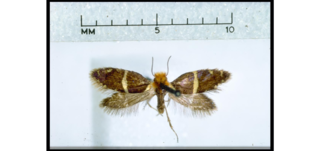
Sabatinca ianthina is a species of moth belonging to the family Micropterigidae. It was described by Alfred Philpott in 1921. It is endemic to New Zealand. This species can be found on both the North and the South Islands from the Hawkes Bay down to Westland. The adults of this species are on the wing from the end of September until the middle of December. Although this species resembles Zealandopterix zonodoxa, S. ianthina is a larger moth and the range of the two species only overlaps in White Pine Bush Scenic Reserve in the Hawke’s Bay.

Sabatinca caustica is a species of moth belonging to the family Micropterigidae. It was described by Edward Meyrick in 1912. It is endemic to New Zealand and is found in both Southland and at Stewart Island / Rakiura. The adults of this species are variable in appearance with some specimens being mainly white on their forewings while others have forewings that are a more mottled purple-brown colour. Adults are on the wing from the start of October until the middle of December. Larvae feed on the surface of leafy liverworts.

Sabatinca chrysargyra is a species of moth belonging to the family Micropterigidae. It was described by Edward Meyrick in 1886 and is endemic to New Zealand. It can be found from Franz Josef Glacier / Kā Roimata o Hine Hukatere south but only on the western side of the South Island. Adults are on the wing from the beginning of October until the middle of January. Larvae likely feed on foliose liverworts and have been found on species in the genus Plagiochila. The adult moths live in a range of habitats preferring sunny open spaces in forests or snow-tussock grasslands that can range in altitude from near sea level up to 1,230 m. This species is very similar in appearance to Sabatinca aemula and dissection of genitalia is required to distinguish between the two species.

Sabatinca heighwayi is a species of moth belonging to the family Micropterigidae. It was described by Alfred Philpott in 1927 and is endemic to New Zealand. It can be found north of Lewis Pass in the north west of the South Island. Adult moths are on the wing from late September until the middle of January. The host of the larvae of this species is the foliose liverwort Plagiochila circumcincta.

Sabatinca quadrijuga is a species of moth belonging to the family Micropterigidae. This species is endemic to New Zealand and is found in the Dunedin area and in Southland. The range of S. quadrijuga overlaps with the range of S. caustica.S. quadrijuga was first scientifically described by Edward Meyrick in 1912. As a result of its predominantly black forewings this species looks similar to a small caddisfly. The adults of this species are on the wing from September to November. Larvae feed on leafy liverwort species and the adults likely feed on fern spores or sedge pollen. The species prefers to live in well lit but damp mossy habitats. The nearest relative of S. quadrijuga is S. aurantissima.
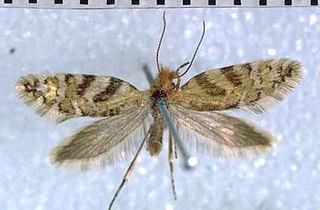
Sabatinca aenea, also known as the Banks Peninsula Metallic, is a species of moth belonging to the family Micropterigidae. This species was first described by George Hudson in 1923. It is endemic to New Zealand and is found in Kaikōura and in the Canterbury regions. The larvae of this species is a deep grey green colour and likely feeds on foliose liverwort species. The adult moths likely feed on fern spores or sedge pollen. This species prefers moist semi-shaded habitat and the adults are on the wing from the start of October until the middle of December.

Mnesarchella loxoscia is a species of primitive moth in the family Mnesarchaeidae. It is endemic to New Zealand. and is found in the Northland, Auckland, Coromandel, Waikato, Bay of Plenty, Taranaki, Taupō, Gisborne, Rangitīkei, Wellington and the Marlborough Sounds regions. Adults of this species are normally on the wing from December and January but can be on the wing as early as October.

Physetica prionistis is a moth of the family Noctuidae. It was described by Edward Meyrick in 1887. It is endemic to New Zealand and is widespread throughout the North, South and Chatham Islands. This species can be found in open clearings of shrubland and forest at altitudes from sea level up to the alpine zone. Adults are on the wing throughout the year and are attracted to sugar traps and occasionally to light. The life history of this species is unknown as are the larval host species.
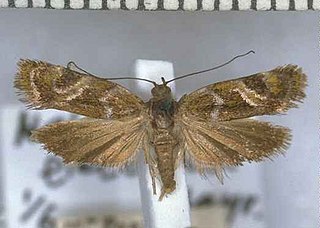
Hierodoris electrica is a moth of the family Oecophoridae. It was described by Edward Meyrick in 1889. It is endemic to New Zealand, where it has been reported from the northern and southern parts of the South Island. The larva of H. electrica has yet to be described. The wingspan is between 15 and 16.5 mm. The ground colour of the forewings is dark brown, with narrow yellow scales overlaying this base colour. The hindwings are brown. The known larval host species is Olearia nummulariifolia.
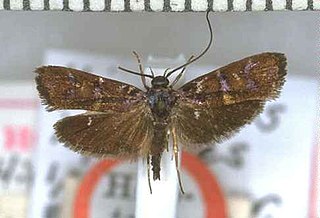
Hierodoris iophanes is a moth of the family Oecophoridae. It was described by Edward Meyrick in 1912. This species can be distinguished from others in its genus by the purple metallic colouration as well as the blue-white mark on its forewings. It is endemic to New Zealand, where it has been recorded from Auckland to Southland. This species inhabits native forest or scrub, with the adults preferring open glades. They are known to be on the wing from November until February and fly during daylight hours, being active on hot sunny days. Larvae feed on the interior of twigs of Prumnopitys ferruginea. The twigs had evidence of oviposition scars of cicadas and the larvae were collected in October after reddish-brown frass indicated their location within the twigs.

Rhinorhynchus rufulus is a weevil in the Nemonychidae family. It is endemic to New Zealand and was first described by Thomas Broun in 1880. This species is found in both the North, South and Stewart Islands from the sub-alpine zone down to sea-level. Adults can be observed all months of the year. Host plants of this weevil species are conifer trees including Podocarpus nivalis and Lepidothamnus laxifolius.

Proteuxoa comma is a species of moth in the family Noctuidae. It is endemic to New Zealand. It can be found in the lower half of the North Island and throughout the South Island, although it appears to be more frequent on the eastern side of these islands, and also is present in Stewart Island. P. comma is very similar in appearance to P. tetronycha but can be distinguished as it is a larger moth with slightly different colouration on, as well as shape of, its forewings. This species pupates in the soil. The adult moths are on the wing from December to April. P. comma may possibly be declining in population and as at 2017 a reassessment of its conservation status is regarded as being needed.
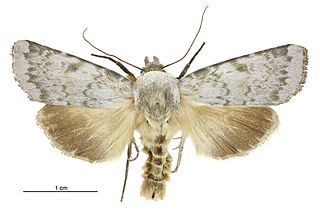
Physetica caerulea is a species of moth of the family Noctuidae. It is endemic to New Zealand and can be found from the centre of the North Island south, including the South and Stewart Islands. The adult moths are variable in appearance but can be distinguished by the bluish tinge to the forewings as well as the underside buff colour. However this species does have several forms including a very dark bluish black form, a brownish form and a green-brown form. It lives in open habitats and can be found in tussock grasslands and dunes and can normally be found from altitudes of sea level up to 900 m. Adults of this species are on the wing from August to April. As at 2017, the life history of is unknown as are the host species of its larvae. However it has been hypothesised that the larval host species is a tomentose plant.

Hoherius meinertzhageni, the ribbonwood fungus weevil, is an endemic New Zealand beetle that has been recorded feeding on the ribbonwood species Plagianthus regius and Plagianthus divaricatus and the mountain lacebark, Hoheria glabrata.

Hierodoris callispora is a moth of the family Oecophoridae. It is endemic to New Zealand and can be found throughout the country from south of the Bay of Plenty. This species inhabits native beech forest. Adults of the species have been found where Muehlenbeckia is common. Adults have also been collected from the flowers of Kunzea ericoides. However the larval host is unconfirmed although it has been hypothesised that larvae of this species feed on Kunzea ericoides flowers. Adults of this species can be distinguished by its orange ruff that contrasts with its dark head and thorax. There is a colour form that exists that has orange scales and an orange coloured fringe on the hindwing. Adults have been collected in December and January and are day flying but are also attracted to light at night. A female specimen has been found with a larva in her oviduct suggesting that this species may give birth to larval young.
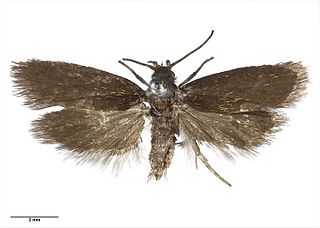
Hierodoris squamea is a moth of the family Oecophoridae. It is endemic to New Zealand and is found in the mountains of Fiordland as well as the Olivine Range in south Westland. This species has a wingspan of between 12 and 13 mm and can be distinguished from similar species as it is very small in size, has a reduced eyespot on its forewings, clearly visible through Scanning Electron Microscope preparations, and has orange-yellow scales overlaying its dark forewing. It prefers open country of tussock grasslands and herbfields at high altitudes. As at 2005 the larvae are unknown. Adults are on the wing in January.

Hierodoris insignis is a species of moth in the family Gelechiidae. It is endemic to New Zealand and has been found in the Nelson/Tasman districts. The larvae are leaf miners and are hosted by Celmisia species. Adults are on the wing in January. It is likely that this species belongs to another genus and as such this species is also known as Hierodoris (s.l.) insignis or 'Hierodoris' insignis.






















